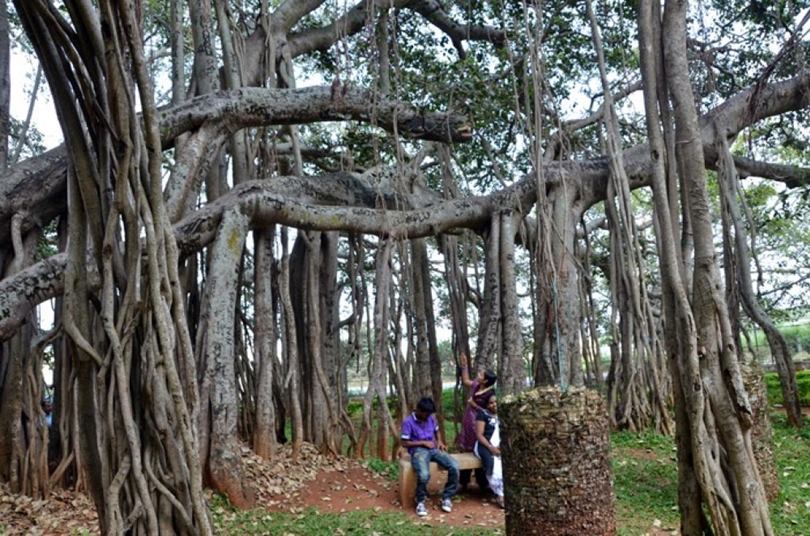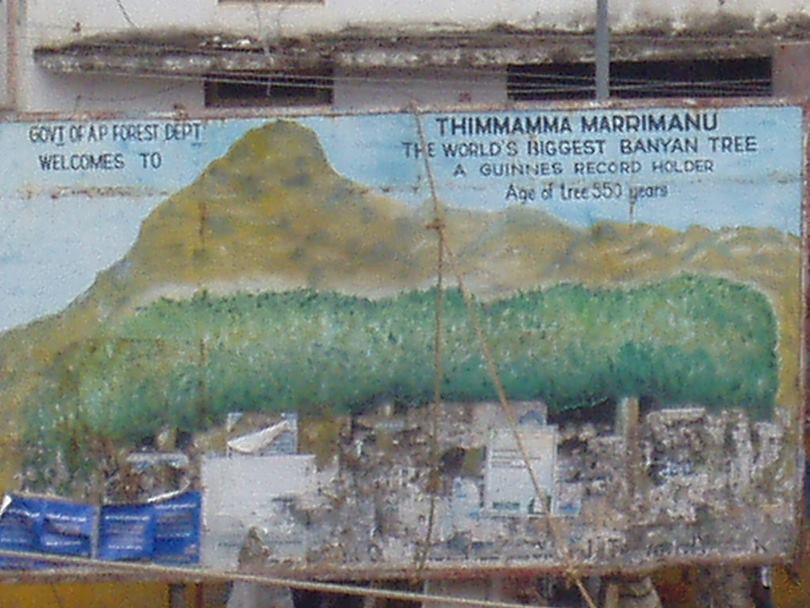Thimmamma Marrimanu — The Indian forest of 19,000 square meters Indian forest of formed by a single tree, "Banyan tree in Telugu," "Marri Chettu in Telugu". The Indian state of Andhra Pradesh, east of the Kadiri forest reserve, Anantapuram, it looks like a large forest. This Andhra Tree is known as Thimmamma Marrimanu, and it was recorded as the largest tree specimen in the world in the Guinness Book of World Records in 1989.
Thimmamma Marrimanu
Banyans, which also include other species, are trees that develop unconventionally, from top to bottom. Initially the seeds germinate in the cracks of the bark of another tree and also in walls of buildings with the roots penetrating the walls and are called stranglers. The banyan tree uses — buds, fruit, leaves, aerial roots, milky sap, roots, and bark can all be used for healing. The banyan tree is also used in rope, paper, a polish for silver and other metals, shellac, and dyes for wool and silk… the banyan tree is very versatile. The banyan tree or marri chettu tree in Telugu మర్రి చెట్టు and marri chettu in kannada ಆಲದ ಮರ. The banyan meaning in telugu is Marri "మర్రి".
The scientific name of the banyan tree is Ficus Benghalensis and in Hindi Bargad, it is very important in the religious aspect, worship trees in India and it is considered the national tree of India. The roots of the banyan tree are associated with Brahma, the trunk with Vishnu, and the leaves with Siva. People tie ties in their branches and place votive figures in the hollows of their roots. The botanical name of the banyan tree is Ficus Benghalensis L. Family: Moraceae. Common Names: Bar, Bat Gaach, Bath, Bot (Bengali); Banyan Fig, Banyan Tree, East Indian Fig Tree
Anantapur Banyan Tree
The extension of the Thimmamma Marrimanu canopy covers the incredible surface of 19,107 square meters (0.019 square kilometers), which is why it seems to constitute a real forest and figure in the Guinness Book of Records as the largest arboreal specimen of the world.
Photo by holidayiq.com
Photo by Theworldofinterestingfacts
Andhra Pradesh mysterious tree
Andhra Pradesh tree – Under the branches of the tree, there is a temple dedicated to Thimmamma, who according to legend would have immolated herself in the place when her husband died in 1434. It is believed that the tree grew right in the place where the funeral pyre, one of its Trunks. In that case, its age would be around 550 years.
Photo by wikimedia.org
Largest tree canopy
Local tradition states that couples without children who come to the temple will conceive at the end of the year, making it a particularly crowded place, but also that a curse will fall on those who cut their leaves.
Photo by Google Maps
Largest banyan tree in Andhra Pradesh
The pilgrims are especially numerous especially during the festival of the Maha Shivaratri (the great night of Siva ) that is celebrated on the night of the thirteenth day of the month Phalguna (between February and March) of the Hindu calendar. That night under the Thimmamma Marrimanu takes place a large Jatara ( nocturnal vigil accompanied by music and dances) to which thousands flock. The villagers claim that under the tree can hold up to 20,000 people.
The Thimmamma Marrimanu still continues to grow and expand, favored by being situated in an environment of agricultural fields with little tree competition around it. Reason for which it has come to have such an impressive extension, with about 4,000 roots-trunk that twist up and down in all directions.
Photo by Avalokarts
Painting of Banyan tree at Puttaparthi Bus Stand Area Photo by Miran Rijavec
Photo by sandhyakotitravel
Photo by travel. in
Photo by Aravindgj
Photo by Aravindgj
Photo by Aravindgj
Banyan tree leaf images
Bargad plant
Thimmamma Marrimanu Google map















mind blowing
ReplyDeleteThanks for sharing this information with us.
ReplyDelete